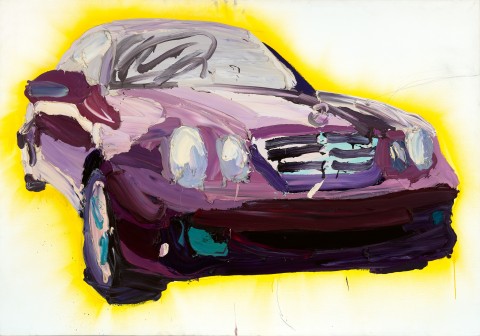WANT WANT WANT, 2006
BEN QUILTY
oil and aerosol on linen
140.0 x 200.0 cm
signed, dated and inscribed with title verso: Want Want Want / oil and aerosol on linen 2006 / Ben Quilty
bears inscription on label on stretcher bar verso: BQ 22 / Want Want Want 2006
GRANTPIRRIE, Sydney
Private collection, Brisbane
Blockprojects Gallery, Melbourne
Private collection, Melbourne, acquired from the above
Slade, L., Ben Quilty, University of Queensland Art Museum, Brisbane, 2009, p. 57 (illus.)
Ben Quilty’s images of cars are not simply painterly depictions of objects of desire but a kind of empathic portraiture that joyfully captures the psyche of the large group of Australian men who love their cars, along with access and participation in the world of hotted up cars and hooning that a certain type of car ownership allows. As a boy from the outer suburbs, Quilty’s interest in this realm comes from a place of understanding. Indeed, he effectively launched his career in 2003 with an exhibition of ‘portraits’ of his 1972 Torana.1 As he has said: ‘For us initiation was performed inside a car. Beer in hand we became valued members of a society and, as the motor screamed, the dizziness of expectation awakened the adult in us.’2
Quilty’s youth was one of testosterone-fuelled binge drinking and risk taking, and the muscle cars that fill his oeuvre in the early 2000s – the nuggety Torana, Ford Falcons and the ubiquitous Aussie ute – are cars that he knows intimately and has most likely behaved badly in. These cars are both an extension of self and a way of presenting oneself to the world, but in Quilty’s hands, they also speak powerfully of our collective desire for a sense of community and our need to belong. Never afraid to unveil the darker side of society’s actions and compulsions, Quilty also paints these cars as terrifying wrecks, their smashed-up distorted bodies highlighting the dire consequences that can arise from the recklessness of youth.
The luscious, thick brushwork of want want want, 2006 conveys this luxury car (a Mercedes) as an object of lust and longing, well beyond the financial capacity of the artist and his mates at the time it was created. Quilty’s thick slabs of paint and use of vibrant colour deftly capture the car’s sleek low-lying body, the way in which its tyres hug the road, and its seemingly innate capacity for speed. While still, it seems to be poised to move – the artist’s confident use of aerosol (the tool of the graffitist) across the grille, bonnet and windscreen capturing a sense of immediacy and haste. Bathed in a glowing yellow halo, this is a car of dreams that seems to point to another stage of life for the artist – one beyond the machismo and potential dangers of his youth. This car offers a different kind of social status, as well stability and success, while also promising the thrill of incredible speed whenever you put your foot down. In depicting these pervasive symbols, Quilty draws on his own past and experiences to highlight the need for men to have other possibilities of ‘becoming’. As he has commented:
‘There’s no initiation process for young men. When you turn 18 you skol a yard glass and you spew on yourself and then you’re supposedly a male that’s got something to give to society. It’s just so far from how it should work. It’s definitely informed my work; it’s what I’m interested in because it’s where I’ve been. It’s what I’ve done.’3
1. Torana, Maunsell Wickes Gallery, Sydney, 2003
2. The artist, quoted in Ben Quilty Live! An Interpretative Guide, University of Queensland Art Museum, Brisbane, 2009, p. 5, at https://issuu.com/uqartmuseum/docs/benquiltyinterpretiveguide, accessed 24 March 2023
3. Low, L. A., “The hot seat: Ben Quilty”, Sydney Morning Herald, 18 March 2007, at https://www.smh.com.au/entertainment/art-and-design/the-hot-seat-ben-qui..., accessed 24 March 2023
KELLY GELLATLY
